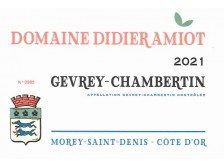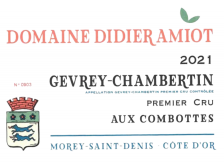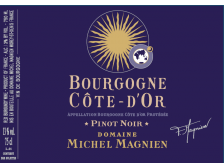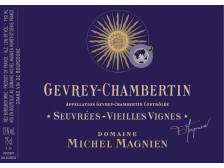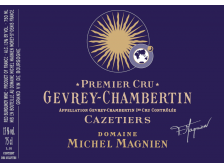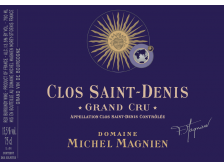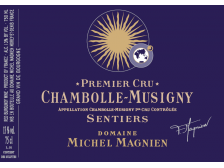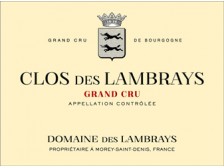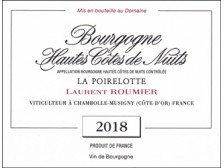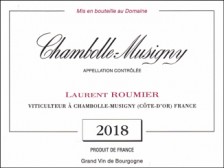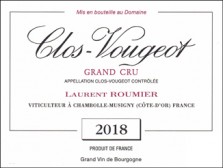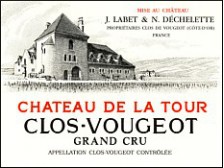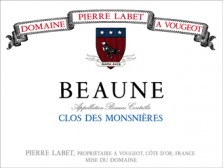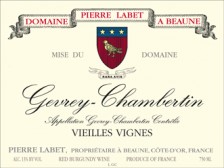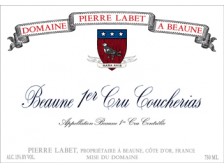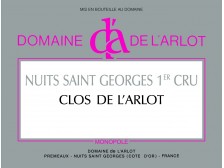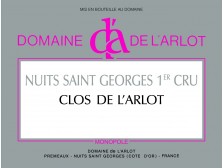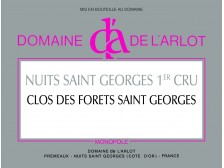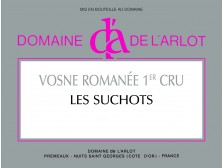Catalog
-
Following the sharing of the Pierre Amiot estate with his brother Jean-Louis in 2020, Didier Amiot created his own 3.2 hectare estate in Gevrey, Morey and Chambolle, which he immediately put into organic conversion (certification expected in 2023).
Didier Amiot 's guiding principle is to produce wines that are always seductive, spontaneously fruity, fleshy and silky-textured. This contract will be perfectly fulfilled in 2021 with his second vintage.
More- To keep or to drink:
- Ready to drink
- Apogée:
- 2028-2038
- Organic certification:
- 2023
-
Following the sharing of the Pierre Amiot estate with his brother Jean-Louis in 2020, Didier Amiot created his own 3.2 hectare estate in Gevrey, Morey and Chambolle, which he immediately put into organic conversion (certification expected in 2023).
Didier Amiot 's guiding principle is to produce wines that are always seductive, spontaneously fruity, fleshy and silky-textured. This contract will be perfectly fulfilled in 2021 with his second vintage.
More- To keep or to drink:
- Wait 5 to 10 years
- Apogée:
- 2028-2038
- Organic certification:
- 2023
-
Frédéric Magnien (Michel's son) is part of this new generation of winemakers who have awakened their family estate. Since 2015 (conversion to organic and biodynamic, abandonment of new barrels and introduction of earthenware jars in the maturing process...), the wines of the estate have progressed magnificently in charm, precision and aromatic finesse. This without losing the color and richness that are the customary signature of the wines of the domain. Rated one star in the Revue du Vin de France guide.
Located on the northern part of the Côte de Nuits, the Michel Magnien estate is at the head of an exceptional patrimony, 18 ha divided into 23 parcels on the very best climates of Gevrey (Charmes-Chambertin, Cazetiers...), Morey (Clos Saint-Denis, Clos de la Roche...) and Chambolle (Sentiers...).More- To keep or to drink:
- Ready to drink
- Apogée:
- 2025-2032
- Organic certification:
- 2012
-
Frédéric Magnien (Michel's son) is part of this new generation of winemakers who have awakened their family estate. Since 2015 (conversion to organic and biodynamic, abandonment of new barrels and introduction of earthenware jars in the maturing process...), the wines of the estate have progressed magnificently in charm, precision and aromatic finesse. This without losing the color and richness that are the customary signature of the wines of the domain. Rated one star in the Revue du Vin de France guide.
Located on the northern part of the Côte de Nuits, the Michel Magnien estate is at the head of an exceptional patrimony, 18 ha divided into 23 parcels on the very best climates of Gevrey (Charmes-Chambertin, Cazetiers...), Morey (Clos Saint-Denis, Clos de la Roche...) and Chambolle (Sentiers...).More- To keep or to drink:
- Ready to drink
- Apogée:
- 2025-2032
- Organic certification:
- 2012
-
Frédéric Magnien (Michel's son) is part of this new generation of winemakers who have awakened their family estate. Since 2015 (conversion to organic and biodynamic, abandonment of new barrels and introduction of earthenware jars in the maturing process...), the wines of the estate have progressed magnificently in charm, precision and aromatic finesse. This without losing the color and richness that are the customary signature of the wines of the domain. Rated one star in the Revue du Vin de France guide.
Located on the northern part of the Côte de Nuits, the Michel Magnien estate is at the head of an exceptional patrimony, 18 ha divided into 23 parcels on the very best climates of Gevrey (Charmes-Chambertin, Cazetiers...), Morey (Clos Saint-Denis, Clos de la Roche...) and Chambolle (Sentiers...).More- To keep or to drink:
- Wait 3 to 5 years
- Apogée:
- 2028-2040
- Organic certification:
- 2012
-
Frédéric Magnien (Michel's son) is part of this new generation of winemakers who have awakened their family estate. Since 2015 (conversion to organic and biodynamic, abandonment of new barrels and introduction of earthenware jars in the maturing process...), the wines of the estate have progressed magnificently in charm, precision and aromatic finesse. This without losing the color and richness that are the customary signature of the wines of the domain. Rated one star in the Revue du Vin de France guide.
Located on the northern part of the Côte de Nuits, the Michel Magnien estate is at the head of an exceptional patrimony, 18 ha divided into 23 parcels on the very best climates of Gevrey (Charmes-Chambertin, Cazetiers...), Morey (Clos Saint-Denis, Clos de la Roche...) and Chambolle (Sentiers...).More- To keep or to drink:
- Wait 5 to 10 years
- Apogée:
- 2030-2045
- Organic certification:
- 2012
-
Frédéric Magnien (Michel's son) is part of this new generation of winemakers who have awakened their family estate. Since 2015 (conversion to organic and biodynamic, abandonment of new barrels and introduction of earthenware jars in the maturing process...), the wines of the estate have progressed magnificently in charm, precision and aromatic finesse. This without losing the color and richness that are the customary signature of the wines of the domain. Rated one star in the Revue du Vin de France guide.
Located on the northern part of the Côte de Nuits, the Michel Magnien estate is at the head of an exceptional patrimony, 18 ha divided into 23 parcels on the very best climates of Gevrey (Charmes-Chambertin, Cazetiers...), Morey (Clos Saint-Denis, Clos de la Roche...) and Chambolle (Sentiers...).More- To keep or to drink:
- Wait 1 to 2 years
- Apogée:
- 2026-2036
- Organic certification:
- 2012
-
A grand cru with an almost monopoly, Clos des Lambrays is one of the best exposed terroirs on the Côte de Nuits, combining the power of a Chambertin with the velvety character of a Bonnes-Mares. Bought in 2014 by L.V.M.H. and still rated three stars in the Revue du Vin de France guide.
The 2022 vintage in the press:
La Revue du Vin de France (March 2024 ): 98+/100 “Cherry core and sweet spices, firm but nuanced, straightforward and straightforward, silky tannins in this dynamic wine, with fine-tuned flavors, carried by a very persistent blast on the finish. Magnificent integration of the whole harvest."
Vinous (N.Martin - January 2024): 96-98/100 “The 2022 Clos des Lambrays Grand Cru is a blend of 11 different cuvées and includes, for the first time, the plot of "30 Rangs". This vintage includes 80% whole bunches, and like La Richemoine, it is deftly subsumed on the nose, which blossoms with vivacious red berry fruit, forest floor, white truffle, and light autumn leaf scents. The palate is medium-bodied with fine tannins, a svelte Clos des Lambrays with a slightly chalky, mineral-rich finish. Very tender and complex, this is undoubtedly a great wine with a long-term future.”
Bettane + Desseauve (Guide 2026) : 99/100
More- To keep or to drink:
- Wait 5 to 10 years
- Apogée:
- 2030-2044
-
If the Georges Roumier estate is one of the best known in the Côte de Nuits, the Laurent Roumier estate shines on the contrary by its discretion. However, Laurent Roumier is one of Georges' grandsons, at the head of a beautiful wine-growing heritage, 12 ha of old vines (40 years old) almost exclusively on Chambolle-Musigny, run without fertilizer or weed killer. His wines know how to be greedy while remaining fine and distinguished, with a skillfully dosed breeding. Most reasonable prices (for the appellation).
More- To keep or to drink:
- Ready to drink
- Apogée:
- 2026-2035
-
If the Georges Roumier estate is one of the best known in the Côte de Nuits, the Laurent Roumier estate shines on the contrary by its discretion. However, Laurent Roumier is one of Georges' grandsons, at the head of a beautiful wine-growing heritage, 12 ha of old vines (40 years old) almost exclusively on Chambolle-Musigny, run without fertilizer or weed killer. His wines know how to be greedy while remaining fine and distinguished, with a skillfully dosed breeding. Most reasonable prices (for the appellation).
More- To keep or to drink:
- Wait 1 to 2 years
- Apogée:
- 2026-2035
-
If the Georges Roumier estate is one of the best known in the Côte de Nuits, the Laurent Roumier estate shines on the contrary by its discretion. However, Laurent Roumier is one of Georges' grandsons, at the head of a beautiful wine-growing heritage, 12 ha of old vines (40 years old) almost exclusively on Chambolle-Musigny, run without fertilizer or weed killer. His wines know how to be greedy while remaining fine and distinguished, with a skillfully dosed breeding. Only the more massive Clos Vougeot stands out for its vigour and firmness. Most reasonable prices (for the appellation).
More- To keep or to drink:
- Wait 5 to 10 years
- Apogée:
- 2026-2035
-
If the Georges Roumier estate is one of the best known in the Côte de Nuits, the Laurent Roumier estate shines on the contrary by its discretion. However, Laurent Roumier is one of Georges' grandsons, at the head of a beautiful wine-growing heritage, 12 ha of old vines (40 years old) almost exclusively on Chambolle-Musigny, run without fertilizer or weed killer. His wines know how to be greedy while remaining fine and distinguished, with a skillfully dosed breeding. Only the more massive Clos Vougeot stands out for its vigour and firmness. Most reasonable prices (for the appellation).
More- To keep or to drink:
- Wait 5 to 10 years
- Apogée:
- 2026-2035
-
Owning the largest parcel (6 ha) of Clos Vougeot and the only producer vinifying and maturing its wines within the Clos, Château de la Tour is the custodian of the Clos Vougeot tradition. Always vinified unstemmed, its wines are powerful (certified organic from the 2021 vintage), structured and long-lasting.
Rated two stars in the Revue du Vin de France annual guide.
The 2023 vintage in the press:
La Revue du Vin de France (Guide 2026) : 95/100 "Tasted before bottling, the Clos-de-Vougeot is made from 50% whole grapes. Well-ripened and lively, this chewy, energetic wine is quite supple, pulpy on the mid-palate, spicy and persistent."
More- To keep or to drink:
- Wait 5 to 10 years
- Apogée:
- 2032-2044
- Organic certification:
- 2021
-
Owning the largest parcel (6 ha) of Clos Vougeot and the only producer vinifying and maturing its wines within the Clos, Château de la Tour is the custodian of the Clos Vougeot tradition. Always vinified unstemmed, its wines are powerful (certified organic from the 2021 vintage), structured and long-lasting.
Rated two stars in the Revue du Vin de France annual guide.
The 2022 vintage in the press:
Vinous (N.Martin - January 2024): 91-93/100 “The 2022 Clos Vougeot Cuvée Classique Grand Cru includes around 50 % whole clusters. This has a very well-defined bouquet with black cherries, raspberry, briar and light truffle aromas. The palate is medium-bodied with supple tannins, fresh and saline, silky smooth and what feels like a more approachable Clos Vougeot as Edouard Labet intends. Yet it has the substance to age over 15-20 years.”
Bourgogne Ajourd'hui (February-March 2025): 16.5/20 "Fine, spicy, liquorice nose with notes of black cherries. Delicious, greedy, tender palate with silky tannins and intense fruit. Long, delicate finish."
More- To keep or to drink:
- Wait 5 to 10 years
- Apogée:
- 2031-2042
- Organic certification:
- 2021
-
Owning the largest parcel (6 ha) of Clos Vougeot and the only producer vinifying and maturing its wines within the Clos, Château de la Tour is the custodian of the Clos Vougeot tradition. Always vinified unstemmed, its wines are powerful (certified organic from the 2021 vintage), structured and long-lasting.
Rated two stars in the Revue du Vin de France annual guide.
The 2021 vintage in the press:
La Revue du Vin de France (Guide 2024): 94/100 “Accessible and dense, clos-de-vougeot is spicy and tender on the attack: concentration arrives mid-palate with a full-bodied, firm, minty finish.”
Vinous (N.Martin - November 2022): 90-92/100 "The 2021 Clos Vougeot Grand Cru Cuvée Classique has a bright and quite lively bouquet, red and black fruit, juniper and hawthorn. The palate is medium-bodied with fine definition, taut and fresh, brown spices infusing the peppery, tobacco-tinged finish. It needs to cohere a little before bottling, though the racking will assist that."
Bourgogne Ajourd'hui (February-March 2025): 16/20 "Fragrant, rich nose with lovely floral and fruity notes. Intense on the palate, with a fruity attack that stretches into a long finish with a subtle hint of toast".
More- To keep or to drink:
- Wait 5 to 10 years
- Apogée:
- 2031-2042
- Organic certification:
- 2021
-
François Labet, owner of Château de la Tour in Vougeot, manages the family estate (10 ha in Beaune and Gevrey) with equal talent. He applies the same quality principles: organic farming, non-éraflée harvesting, long ageing (two winters minimum). Far from being the most talked-about domaine, but a wise choice for connoisseurs, according to Bourgogne Aujourd'hui: "to be seized as a matter of urgency, as the quality of the wines has been so consistent for a very long time".
More- To keep or to drink:
- Ready to drink
- Apogée:
- 2022-2030
- Organic certification:
- 2021
-
François Labet, owner of Château de la Tour in Vougeot, manages the family estate (10 ha in Beaune and Gevrey) with equal talent. He applies the same quality principles: organic farming, non-éraflée harvesting, long ageing (two winters minimum). Far from being the most talked-about domaine, but a wise choice for connoisseurs, according to Bourgogne Aujourd'hui: "to be seized as a matter of urgency, as the quality of the wines has been so consistent for a very long time".
The 2023 vintage in the press:
En Magnum (October 2025): 93/100 "A blend of terroirs from the appellation (including En Justice, Jouise and Les Crais), this straightforward red offers beautiful mineral sensations and a successful balance between structure and accessibility."
More- To keep or to drink:
- Wait 3 to 5 years
- Apogée:
- 2028-2038
- Organic certification:
- 2021
-
François Labet, owner of Château de la Tour in Vougeot, manages the family estate (10 ha in Beaune and Gevrey) with equal talent. He applies the same quality principles: organic farming, non-éraflée harvesting, long ageing (two winters minimum). Far from being the most talked-about domaine, but a wise choice for connoisseurs, according to Bourgogne Aujourd'hui: "to be seized as a matter of urgency, as the quality of the wines has been so consistent for a very long time".
The 2020 vintage in the press :
Vinous (N.Martin - November 2023): 90-92/100 "The 2022 Gevrey-Chambertin Vieilles Vignes, a blend of La Justice, Les Crais and La Jouises, has a pleasant mulberry and raspberry scented bouquet, just a hint of lavender/potpourri in the background. The palate is medium-bodied with fine tannins, quite a "cool" Gevrey-Chambertin with a hint of brine lending sapidity on the finish. Promising."
More- To keep or to drink:
- Wait 1 to 2 years
- Apogée:
- 2028-2038
- Organic certification:
- 2021
-
François Labet, owner of Château de la Tour in Vougeot, manages the family estate (10 ha in Beaune and Gevrey) with equal talent. He applies the same quality principles: organic farming, non-éraflée harvesting, long ageing (two winters minimum). Far from being the most talked-about domaine, but a wise choice for connoisseurs, according to Bourgogne Aujourd'hui: "to be seized as a matter of urgency, as the quality of the wines has been so consistent for a very long time".
The 2020 vintage in the press :
Vinous (N.Martin - November 2019): 90-92/100 "The 2020 Gevrey-Chambertin Vieilles Vignes actually works well on the nose with pure blackcurrant, raspberry and violet scents on the nose. The palate is sweet and ripe on the entry with crunched redcurrant and cranberry fruit, quite Morey-like in style, with fine susbtance on the finish. Though the Edouard Labet clearly rued having had to de-stem, it greatly enhances this Gervey."
More- To keep or to drink:
- Wait 1 to 2 years
- Apogée:
- 2028-2038
- Organic certification:
- 2021
-
François Labet, owner of Château de la Tour in Vougeot, manages the family estate (10 ha in Beaune and Gevrey) with equal talent. He applies the same quality principles: organic farming, non-éraflée harvesting, long ageing (two winters minimum). Far from being the most talked-about domaine, but a wise choice for connoisseurs, according to Bourgogne Aujourd'hui: "to be seized as a matter of urgency, as the quality of the wines has been so consistent for a very long time".
More- To keep or to drink:
- Wait 1 to 2 years
- Apogée:
- 2026-2036
- Organic certification:
- 2021
-
François Labet, owner of Château de la Tour in Vougeot, manages the family estate (10 ha in Beaune and Gevrey) with equal talent. He applies the same quality principles: organic farming, non-éraflée harvesting, long ageing (two winters minimum). Far from being the most talked-about domaine, but a wise choice for connoisseurs, according to Bourgogne Aujourd'hui: "to be seized as a matter of urgency, as the quality of the wines has been so consistent for a very long time".
The 2020 vintage in the press:
Bourgogne Aujourd'hui (October 2023): 18/20 “Velvety nose, with notes of cherries, raspberries, violets, a background of chocolate, mocha... Concentrated on the palate, with generous fruit, sweet tannins and great elegance”.
Vinous (N.Martin - November 2019): 88-90/100 "The 2020 Beaune Coucherias 1er Cru [...] has more delineation and purity compared to the Beaune Marconnets, black plum and just a touch of raspberry and iris petal. The palate is medium-bodied with sappy black fruit, very smooth, maybe th new oak just a little vocal on the finish though that will be subsumed with time. Fine."
More- To keep or to drink:
- Wait 1 to 2 years
- Apogée:
- 2026-2036
- Organic certification:
- 2021
-
François Labet, owner of Château de la Tour in Vougeot, manages the family estate (10 ha in Beaune and Gevrey) with equal talent. He applies the same quality principles: organic farming, non-éraflée harvesting, long ageing (two winters minimum). Far from being the most talked-about domaine, but a wise choice for connoisseurs, according to Bourgogne Aujourd'hui: "to be seized as a matter of urgency, as the quality of the wines has been so consistent for a very long time".
The 2019 vintage in the press :
Vinous (N.Martin - October 2020): 90-92/100 "The 2019 Beaune Coucherias 1er Cru [...] has a charming bouquet of red currant and cranberry scents, the whole cluster (around 70%, higher than 2018) lending a little spiciness. The well-balanced palate is full of tension and salinity, and the shimmering, vivacious finish is very Pommard in style. An excellent Beaune that comes highly recommended."
More- To keep or to drink:
- Ready to drink
- Apogée:
- 2024-2032
- Organic certification:
- 2021
-
Owned by AXA Millésimes since 1987, Domaine de l'Arlot spans 15 hectares between Nuits-Saint-Georges (Prémeaux) and Vosne-Romanée. This is an estate of excellence, producing some of the most intense, precise whites on the Côte de Nuits, as well as dense reds with chiselled structures that are simultaneously fleshy and delicate.
Rated two stars in the Revue du Vin de France guide (from 2026 onwards).
The 2023 vintage in the press:
La Revue du Vin de France (Guide 2026) : 94/100 “With its vigour, aniseed flavours and unique personality, the Clos de l'Arlot white is a great success.”
More- To keep or to drink:
- Wait 3 to 5 years
- Apogée:
- 2028-2038
- Organic certification:
- 2022
-
Owned by AXA Millésimes since 1987, Domaine de l'Arlot spans 15 hectares between Nuits-Saint-Georges (Prémeaux) and Vosne-Romanée. This is an estate of excellence, producing some of the most intense, precise whites on the Côte de Nuits, as well as dense reds with chiselled structures that are simultaneously fleshy and delicate.
Rated two stars in the Revue du Vin de France guide (from 2026 onwards).
The 2022 vintage in the press:
Vinous (N.Martin - January 2024): 91-93/100 “The 2022 Nuits Saint-Georges Blanc Clos de l'Arlot 1er Cru was taken from tank on the lees before filtration and fining. Aged in 25% new oak, it offers pretty apple blossom, gooseberry and persimmon scents that gradually unfold, though never completely let loose. The palate is well-balanced, with noticeable weight and left on the entry. This is a concentrated white Burgundy, yet Géraldine Godot manages to retain sufficient tension and poise, elongating the finish. Apparently, this bottle had opened up considerably since being uncorcked the previous day. Touch og ginger on the aftertaste. Punchy!”
More- To keep or to drink:
- Wait 1 to 2 years
- Apogée:
- 2027-2038
- Organic certification:
- 2022
-
Owned by AXA Millésimes since 1987, Domaine de l'Arlot spans 15 hectares between Nuits-Saint-Georges (Prémeaux) and Vosne-Romanée. This is an estate of excellence, producing some of the most intense, precise whites on the Côte de Nuits, as well as dense reds with chiselled structures that are simultaneously fleshy and delicate.
Rated two stars in the Revue du Vin de France guide (from 2026 onwards).
The 2021 vintage in the press :
Vinous (N.Martin - May): 93/100 "The 2021 Nuits Saint-Georges Clos de l'Arlot Blanc 1er Cru has a more complex bouquet with orange blossom, walnut oil and crushed stone scents that unfurl in the glass. There is a real sense of energy and fine delineation. The palate is beautifully balanced with real intensity and drive; the acidity maintains tension and energy. Wonderful detail and nuance on the finish with touches of hazelnut, chamomile and spices. Long and tender, this is a top-notch...what I thought was Meursault but turns out to be Nuits Saint-Georges!"
More- To keep or to drink:
- Wait 1 to 2 years
- Apogée:
- 2027-2038
- Organic certification:
- 2022
-
Owned by AXA Millésimes since 1987, Domaine de l'Arlot spans 15 hectares between Nuits-Saint-Georges (Prémeaux) and Vosne-Romanée. This is an estate of excellence, producing some of the most intense, precise whites on the Côte de Nuits, as well as dense reds with chiselled structures that are simultaneously fleshy and delicate.
Rated two stars in the Revue du Vin de France guide (from 2026 onwards).
The 2020 vintage in the press :
Vinous (N.Martin - January 2022): 89-91/100 "The 2020 Nuits Saint-Georges Clos de l'Arlot Blanc 1er Cru is well defined on the nose, although it does not quite possess the mineralité that I found on the 2019 las year. The palate is well balanced with good weight, quite towards the finish."
More- To keep or to drink:
- Wait 3 to 5 years
- Apogée:
- 2028-2040
- Organic certification:
- 2022
-
Owned by AXA Millésimes since 1987, Domaine de l'Arlot spans 15 hectares between Nuits-Saint-Georges (Prémeaux) and Vosne-Romanée. This is an estate of excellence, producing some of the most intense, precise whites on the Côte de Nuits, as well as dense reds with chiselled structures that are simultaneously fleshy and delicate.
Rated two stars in the Revue du Vin de France guide (from 2026 onwards).
The 2023 vintage in the press :
La Revue du Vin de France (Guide 2026) : 93/100 "The red version is well-crafted and infused, but its fruitiness is diminished by slightly drying ageing."
More- To keep or to drink:
- Wait 3 to 5 years
- Apogée:
- 2027-2038
- Organic certification:
- 2022
-
Owned by AXA Millésimes since 1987, Domaine de l'Arlot spans 15 hectares between Nuits-Saint-Georges (Prémeaux) and Vosne-Romanée. This is an estate of excellence, producing some of the most intense, precise whites on the Côte de Nuits, as well as dense reds with chiselled structures that are simultaneously fleshy and delicate.
Rated two stars in the Revue du Vin de France guide (from 2026 onwards).
The 2023 vintage in the press :
La Revue du Vin de France (Guide 2026) : 94/100 "Clos des Forêts has smoky notes and quite pronounced blond oak, which we feel oversimplifies the terroir."
More- To keep or to drink:
- Wait 5 to 10 years
- Apogée:
- 2032-2045
- Organic certification:
- 2022
-
Owned by AXA Millésimes since 1987, Domaine de l'Arlot spans 15 hectares between Nuits-Saint-Georges (Prémeaux) and Vosne-Romanée. This is an estate of excellence, producing some of the most intense, precise whites on the Côte de Nuits, as well as dense reds with chiselled structures that are simultaneously fleshy and delicate.
Rated two stars in the Revue du Vin de France guide (from 2026 onwards).
The 2022 vintage in the press:
Vinous (N.Martin - January 2024): 94-96/100 “The 2022 Nuits Saint-Georges Clos des Fôrets Saint-Georges 1er Cru was also raised in 40% new oak [Incidentally, 0.6ha will be planted with Chardonnay in 2024]. Slightly deeper in color compared to the Clos de l'Arlot, this has slightly more cohesion and complexity on the nose: dark cherries and crushed stone, a hint of wilted rose petals in the background. The palate is medium-bodied with beautifully integrated new oak, lending this a velvety veneer. It is a little plush yet with equivalent tension and a detailed, slightly piquant finish. This is an outstanding Nuits Saint-Georges from the Domaine.”
More- To keep or to drink:
- Wait 5 to 10 years
- Apogée:
- 2028-2039
- Organic certification:
- 2022
-
Owned by AXA Millésimes since 1987, Domaine de l'Arlot spans 15 hectares between Nuits-Saint-Georges (Prémeaux) and Vosne-Romanée. This is an estate of excellence, producing some of the most intense, precise whites on the Côte de Nuits, as well as dense reds with chiselled structures that are simultaneously fleshy and delicate.
Rated two stars in the Revue du Vin de France guide (from 2026 onwards).
The 2022 vintage in the press:
Vinous (N.Martin - January 2024): 93-95/100 “The 2022 Vosne-Romanée Les Suchots 1er Cru, matured in 40% new oak, is intense on the nose, opulent yet controlled with mainly red berry fruit, allspice and rose petal scents, just a hint of black olive emerging with time. Very well-defined. The medium-bodied palate comes armed with a voluptuous entry, almost viscous in texture, intense yet delineated with a gradual build to its sweet and detailed finish. This will require four to five years to open for business, but it is certainly a "serious" Les Suchots with a wonderful spicy edge.”
More- To keep or to drink:
- Wait 3 to 5 years
- Apogée:
- 2028-2038
- Organic certification:
- 2022



